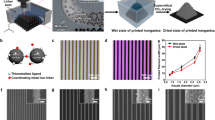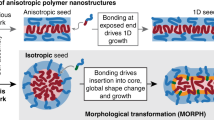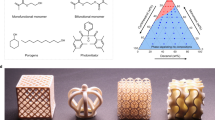Abstract
Controlled morphogenesis and shape replication are challenges for several rapidly developing fields of materials science1,2,3,4. Indeed, although complex forms have been generated by the condensation of inorganic matter in organized media5,6,7,8,9,10,11, the shaping of plastic matter on the micrometre scale is still limited to simple forms that are typically obtained as inverse replicas of channel-like cavities12,13,14 and colloidal crystals15,16. Here we report the fabrication of individual plastic micro-objects that follow an elaborate design and are faithful copies of nanoporous inorganic morphotypes. The direct replica method produces an unprecedented library of curved geometrical solids made of plastics, such as cones, bicones, hollow cylinders, rings, test tubes, clubs and vases. The shape retention of the original structures on the microscale and the creation of a new nanostructure produced objects with homogeneous nanopores of 7 nm and cylindrical microcavities as large as 1 μm. This strategy of shape transcription from one material to another opens new perspectives in microfabrication, separation, anchorage and storage of chemical and biological species. Until now it has not been possible to realize such transformations.
This is a preview of subscription content, access via your institution
Access options
Subscribe to this journal
Receive 12 print issues and online access
$259.00 per year
only $21.58 per issue
Buy this article
- Purchase on Springer Link
- Instant access to full article PDF
Prices may be subject to local taxes which are calculated during checkout




Similar content being viewed by others
References
Mann, S. The chemistry of forms. Angew. Chem. Int. Edn 39, 3392–3406 (2000).
Stupp, S. I. & Braun, P. V. Molecular manipulation of microstructures: biomaterials, ceramics and semiconductors. Science 277, 1242–1248 (1999).
Jiang, P., Bertone, J. F. & Colvin, V. L. A lost-wax approach to monodisperse colloids and their crystals. Science 291, 453–457 (2001).
Trau, M., Yao, N., Kim, E., Whitesides, G. M. & Aksay, I. A. Microscopic patterning of orientated mesoscopic silica through guided growth. Nature 390, 674–676 (1997).
Mann, S. & Ozin, G. A. Synthesis of inorganic materials with complex form. Nature 382, 313–318 (1996).
Yang, H., Coombs, N. & Ozin, G. A. Morphogenesis of shapes and surface patterns in mesoporours silica. Nature 386, 692–695 (1997).
Yang, S. M., Sokolov, I., Coombs, N., Kresge, C. T. & Ozin, G. A. Formation of hollow helicoids in mesoporous silica: supramolecular origami. Adv. Mater. 11, 1427–1431 (1999).
Aizenberg, J., Black, A. J. & Whitesides, G. M. Control of crystal nucleation by patterned self-assembled monolayers. Nature 398, 495–497 (1999).
Li, M., Scgnablegger, H. & Mann, S. Coupled synthesis and self-assembly of nanoparticles to give structures with controlled organization. Nature 402, 393–395 (1999).
Wu, Y. et al. Composite mesostructures by nano-confinement. Nature Mater. 3, 816–822 (2004).
Lu, Y. et al. Aerosol-assisted self-assembly of mesostructured spherical nanoparticles. Nature 398, 223–226 (1999).
Steinhart, M. et al. Polymer nanotubes by wetting of ordered porous templates. Science 296, 1997 (2002).
Cepak, V. M. & Martin, C. R. Preparation of polymeric micro- and nanostructures using a template-based deposition method. Chem. Mater. 11, 1363–1367 (1999).
Moon, S. I. & McCarthy, T. J. Template synthesis and self-assembly of nanoscopic polymer ‘‘pencils’’. Macromolecules 36, 4253–4255 (2003).
Yang, Z., Huck, W. T. S., Clarke, S. M., Tajbakhsh, A. R. & Terentjev, E. M. Shape-memory nanoparticles from inherently non-spherical polymer colloids. Nature Mater. 4, 486–490 (2005).
Johnson, S. A., Ollivier, P. J. & Mallouk, T. E. Ordered mesoporous polymers of tunable pore size from colloidal silica templates. Science 283, 963–965 (1999).
Yang, P. et al. Hierarchically ordered oxides. Science 282, 2244–2246 (1998).
Wu, C. G. & Bein, T. Conducting polyaniline filaments in a mesoporous channel host. Science 264, 1757–1759 (1994).
Kageyama, K., Tamazawa, J.-I. & Aida, T. Extrusion polymerization: catalyzed synthesis of crystalline linear polyethylene nanofibers within a mesoporous silica. Science 285, 2113–2115 (1999).
Lu, Y. et al. Self-assembly of mesoscopically ordered chromatic polyacetylene/silica nanocomposites. Nature 410, 913–917 (2001).
Stucky, G. D. Polymers all in a row. Nature 410, 885–886 (2001).
Spange, S. et al. Synthesis of inorganic/organic host-guest hybrid materials by cationic vinyl polymerization within Y zeolites and MCM-41. Chem. Mater. 13, 3698–3708 (2001).
Choi, M. et al. Controlled polymerization in mesoporous silica toward the design of organic-inorganic composite nanoporous materials. J. Am. Chem. Soc. 127, 1924–1932 (2005).
Moller, K. & Bein, T. Inclusion chemistry in periodic mesoporous hosts. Chem. Mater. 10, 2950–2963 (1998).
Johnson, S. A., Khushalani, D., Coombs, N., Mallouk, T. E. & Ozin, G. A. Polymer mesofibers. J. Mater. Chem. 8, 13–14 (1998).
Kresge, C. T., Leonowicz, M. E., Roth, W. J., Vartuli, J. C. & Beck, J. S. Ordered mesoporous molecular sieves synthesized by a liquid-crystal template mechanism. Nature 359, 710–712 (1992).
Sokolov, I., Yang, H., Ozin, G. A. & Kresge, C. T. Radial patterns in mesoporous silica. Adv. Mater. 11, 636–642 (1999).
Sokolov, I. & Kievsky, Y. 3D Design of self-assembled nanoporous colloids. Stud. Surf. Sci. Catal. 156, 433–443 (2005).
Zalusky, A. S., Olayo-Valles, R., Wolf, J. H. & Hillmyer, M. A. Ordered nanoporous polymers from polystyrene-polylactide block copolymers. J. Am. Chem. Soc. 124, 12761–12773 (2002).
Grosso, D. et al. Two-dimensional hexagonal mesoporous silica thin films prepared from block copolymers: detailed characterization and formation mechanism. Chem. Mater. 13, 1848–1856 (2001).
Acknowledgements
We thank the CARIPLO Foundation and the European Network of Excellence (Nanofun-Poly) for financial support. Our thanks are due to S. Ndoni for small angle X-ray scattering measurements, R. Cristina-Reggiani for SEM images, G. Pagani for providing the dye molecule, and M. Beretta and S. Nicali for technical support. M. P. Longhese and M. Clerici are acknowledged for observations of DNA diffusion into micro-objects and M. D. Ward for helpful suggestions. O.T. and Y.S. thank the Swedish Science Council (VR) and the Japan Science and Technology Agency (JST) for financial support.
Author information
Authors and Affiliations
Corresponding author
Ethics declarations
Competing interests
The authors declare no competing financial interests.
Supplementary information
Supplementary Information
Supplementary figures 1 - 12 (PDF 2429 kb)
Rights and permissions
About this article
Cite this article
Sozzani, P., Bracco, S., Comotti, A. et al. Complete shape retention in the transformation of silica to polymer micro-objects. Nature Mater 5, 545–551 (2006). https://doi.org/10.1038/nmat1659
Received:
Accepted:
Published:
Issue Date:
DOI: https://doi.org/10.1038/nmat1659
This article is cited by
-
PEG-stabilized coaxial stacking of two-dimensional covalent organic frameworks for enhanced photocatalytic hydrogen evolution
Nature Communications (2021)
-
Molecular weight fractionation by confinement of polymer in one-dimensional pillar[5]arene channels
Nature Communications (2019)
-
Selective sorting of polymers with different terminal groups using metal-organic frameworks
Nature Communications (2018)
-
Mixing of immiscible polymers using nanoporous coordination templates
Nature Communications (2015)
-
Highly ordered alignment of a vinyl polymer by host–guest cross-polymerization
Nature Chemistry (2013)



